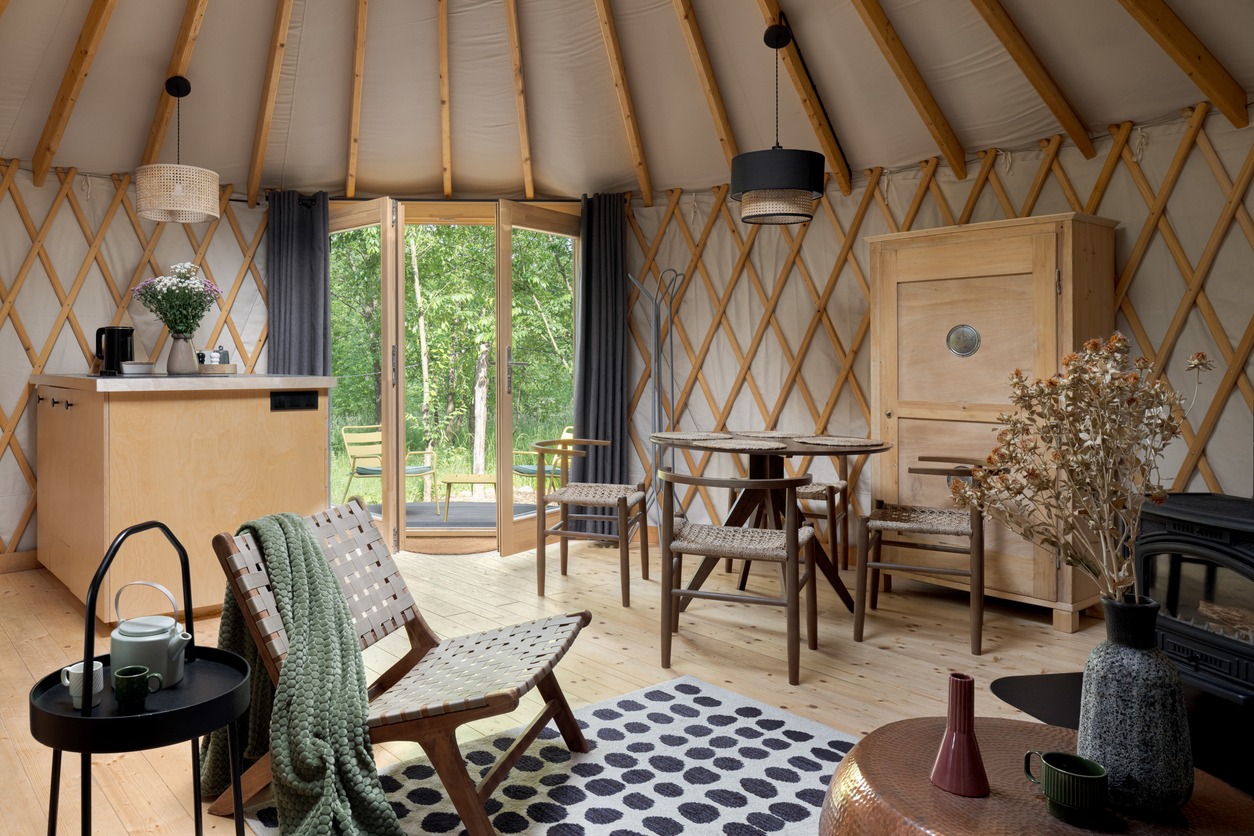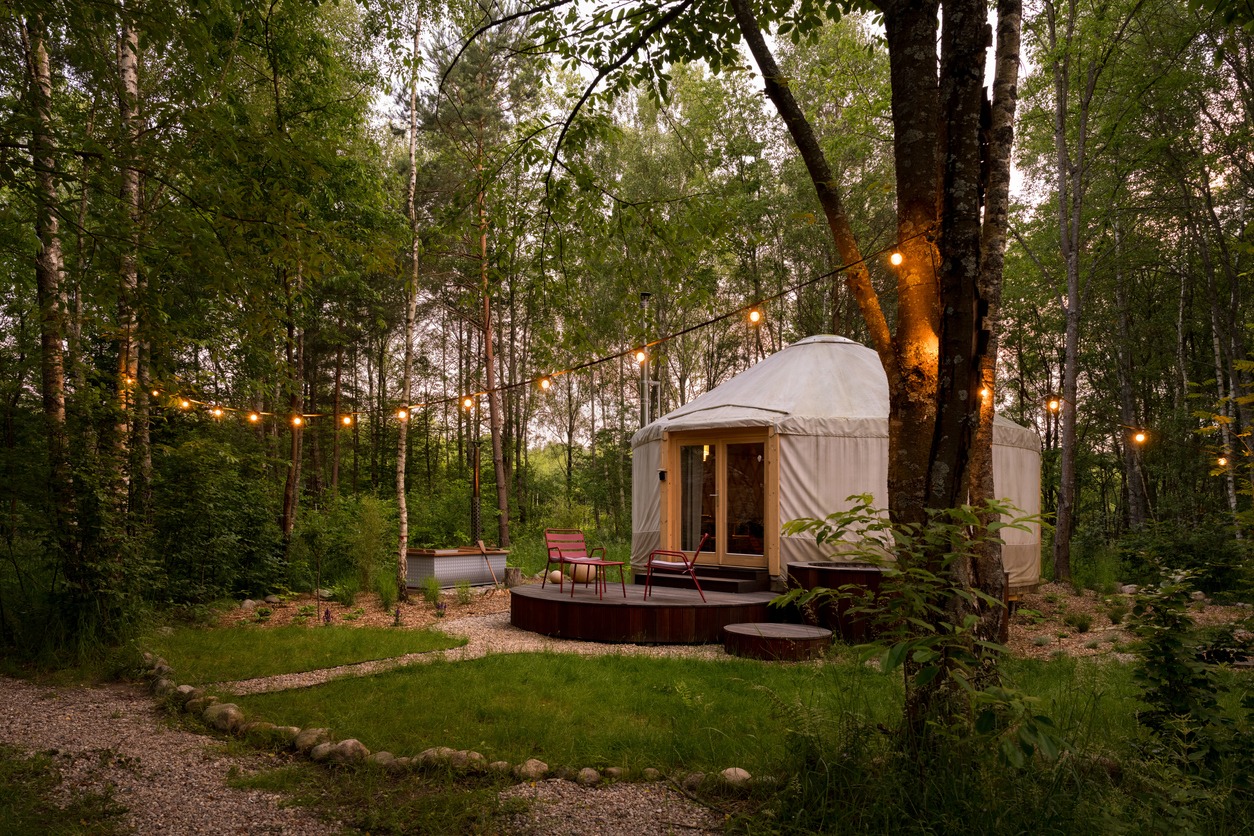Can You Live Full-Time in a Yurt? What to Know About Yurt Life

For anyone craving a minimalist lifestyle that connects deeply with nature, yurt living offers an enticing option. Imagine a home that blends the simplicity of tiny living with the warmth of natural materials, and all of it is surrounded by the beauty of your environment. Full-time yurt living has grown in popularity among those seeking affordable, eco-friendly housing without sacrificing comfort. But what exactly does it take to live in a yurt year-round? Here, we break down the essential information you need, from design and weatherproofing to legal and financial considerations, so you can decide if this lifestyle is for you.
What is a Yurt?
A yurt is a circular, tent-like structure with origins in Central Asia, where nomadic people have used them for centuries. Traditional yurts were made of wood, felt, and fabric and designed to be portable yet sturdy. Modern yurts, while inspired by these traditional designs, offer enhanced durability and the potential for customization. They offer more permanence while still being easy to assemble and dismantle. Their unique structure includes a central skylight, lattice walls, and a flexible framework that creates a spacious, open floor plan.
Today’s yurts blend rustic charm with modern materials like vinyl and insulation layers, making them suitable for year-round use. They’re popular among those looking to downsize, reduce their environmental impact, or simply enjoy a deeper connection to the natural world.
The Practical Appeal of Yurt Living
Why choose a yurt over a traditional home? The answer often lies in the yurt’s versatility, affordability, and simplicity. Yurts are far more cost-effective than conventional homes, with options ranging from DIY kits to fully customized designs. This affordability makes them an attractive choice for anyone looking to minimize housing expenses without sacrificing comfort.
Yurt living also promotes a minimalist lifestyle. With limited space, you’ll find it easier to declutter, reducing the need for excessive belongings. This simplicity can lead to a more intentional way of life, focused on experiences over material items. Additionally, yurts can be customized to fit your specific needs, from insulation upgrades to unique interior layouts. Many yurt dwellers embrace this flexibility, adapting their space to reflect their personality and lifestyle.
Designing and Setting Up Your Yurt Home

Creating a comfortable, functional space within a yurt requires thoughtful planning. Unlike rectangular or square homes, yurts offer a circular layout, which means you’ll need to be creative with furniture placement and storage solutions.
- Maximizing Limited Space: Begin by mapping out key areas like the kitchen, bathroom, and sleeping spaces. Multi-functional furniture, lofts, and built-in storage solutions are essential for keeping your space organized and comfortable. Some yurt owners even build partial walls to create separate rooms without losing the open, spacious feel.
- Embracing Feng Shui or Circular Layout Principles: Due to its circular design, a yurt is ideal for feng shui principles that promote a harmonious flow of energy. Arrange furniture to allow for smooth movement and avoid cluttered spaces, creating a sense of balance that complements the yurt’s natural shape. With the yurt’s open layout, you can incorporate warm, natural colors and materials to create a cozy and inviting environment that feels connected to nature.
- Adding Modern Conveniences: Yurts can be customized to include many modern amenities, such as kitchens, bathrooms, and even electricity. When setting up your kitchen, consider compact appliances and multifunctional storage solutions to make the most of your space. Bathrooms can be designed to include composting toilets and low-flow fixtures to stay eco-friendly. For heating and cooling, options like mini wood stoves or propane heaters work well in yurts and can maintain comfort throughout the year.
Weatherproofing and Seasonal Adaptations
One of the biggest challenges of yurt living is adapting to different weather conditions, as yurts offer less insulation than traditional homes. However, with the right adjustments, you can keep your yurt comfortable year-round.
- Insulation: Insulating your yurt is essential, especially if you live in a climate with cold winters. Traditional yurts often use felt insulation, but modern options include wool or synthetic materials that are both eco-friendly and effective. Many yurt owners use multi-layer insulation for added warmth and even apply thermal curtains over windows to retain heat.
- Heating and Cooling Options: Wood stoves are a popular choice for heating, as they provide consistent warmth and create a cozy atmosphere. Propane heaters or radiant floor heating can also be efficient options. For warmer climates, consider portable AC units or ventilation fans to manage indoor temperature. Some yurt dwellers even set up outdoor shade structures or plant trees nearby to reduce direct sunlight in summer.
- Managing Condensation and Ventilation: Due to the natural materials and fabric structure of yurts, condensation can be a problem. To prevent moisture buildup, ensure your yurt has adequate ventilation. This can be achieved with roof vents, windows, or a dehumidifier if needed. A well-ventilated yurt will keep the indoor environment healthy and reduce issues with mold or mildew.
- Seasonal Adjustments: For those in snowy climates, piling snow around the yurt's base (known as berming) can provide additional insulation. During rainy seasons, make sure your yurt has a waterproof cover, and consider raising the yurt on a platform to keep it dry. With these adjustments, your yurt can become a cozy and resilient home in any season.
Daily Life in a Yurt

Living full-time in a yurt is a unique experience that blends simplicity with an intimate connection to nature. The circular design creates an open, versatile space that’s perfect for creativity and minimalism. Here are a few ways to adapt to daily life in a yurt:
- Adopting a Minimalist Mindset: With limited square footage, you’ll need to select your possessions carefully. Decluttering regularly and organizing storage is essential to maintaining a comfortable, clutter-free environment. Consider multi-functional furniture and clever storage hacks, like hanging organizers or under-bed storage, to keep your belongings neat.
- Embracing Nature and Outdoor Living: Yurts often come with an outdoor-focused lifestyle. Many yurt dwellers extend their living space outside with a deck, garden, or fire pit area. This connection with nature encourages you to spend more time outdoors, whether it’s gardening, hiking, or simply enjoying the fresh air.
- Creating Daily Routines for Maintenance: Yurt life may require a few extra chores compared to traditional homes, such as maintaining your heating system, managing condensation, or checking weatherproofing. Developing a simple routine to keep up with these tasks will make daily yurt life more comfortable and sustainable.
Legal and Financial Considerations
Before diving into yurt life, you’ll need to consider certain legal and financial aspects. While yurts are often viewed as temporary structures, living in them full-time may require permits or specific zoning accommodations.
- Zoning and Permits: Check local regulations, as some areas have restrictions on using yurts as permanent residences. Research zoning laws, building codes, and permit requirements in your area to ensure you’re legally compliant. Some yurt owners find that rural areas with fewer restrictions are more accommodating for full-time yurt living.
- Financing Your Yurt: Traditional home loans may not apply to yurts, as they’re not always considered permanent dwellings by banks. You might need to explore alternative financing options, like personal loans, or save up to purchase your yurt outright. However, yurts can be significantly more affordable than conventional homes, making them an attractive option for those on a budget.
- Insurance and Taxes: Depending on your location, yurts may not be eligible for standard homeowners insurance. Some insurance providers may offer limited coverage, while others may not cover yurts at all. It’s important to check with your insurance provider to understand your options and protect your investment. On the upside, yurts are often taxed at a lower rate than traditional homes, offering potential savings.
Transitioning to Yurt Life: Tips for a Smooth Adjustment
Making the switch to full-time yurt living involves lifestyle changes, but with careful planning, the transition can be rewarding and fulfilling.
- Downsize Your Belongings: Yurts have limited space, so downsizing is essential. Prioritize items that add value to your life and let go of excess belongings. This can be a liberating process, allowing you to embrace a simpler, more intentional lifestyle.
- Learn Basic Maintenance Skills: Since yurts are unique structures, you’ll likely need to handle minor repairs and upkeep yourself. Learning basic maintenance skills, such as managing insulation, sealing the yurt, or maintaining your heating system, will make yurt life much smoother.
- Prepare for Weather Extremes: Each season brings unique challenges, so be prepared for cold winters, hot summers, and everything in between. Ensure your yurt is properly insulated, your heating and cooling systems are in place, and your waterproofing is up to date.
- Connect with the Yurt Community: Many people live in yurts around the world, and connecting with this community can offer valuable support. Look for online forums, local groups, or social media communities where you can ask questions, share tips, and learn from experienced yurt dwellers.
Conclusion
Choosing to live in a yurt full-time is about more than just a change in housing—it's a shift in lifestyle and values. Yurt living invites you to simplify, connect with nature, and create a home that’s intentional and sustainable. While it may have its challenges, the rewards of yurt life—greater freedom, reduced expenses, and a closer bond with the natural world—can make it a fulfilling journey.
As you consider yurt life, remember that every aspect, from space design to seasonal preparation, shapes your experience. For those ready to embrace a simpler, nature-centered way of living, a yurt could be the perfect place to call home.




